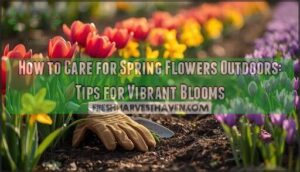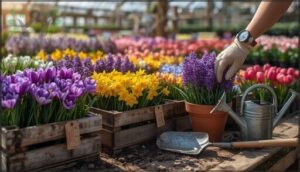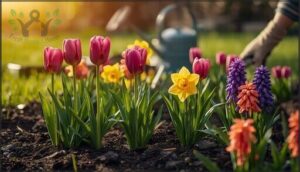This site is supported by our readers. We may earn a commission, at no cost to you, if you purchase through links.
Spring flowers don’t ask for much, but they won’t forgive neglect. Plant a tulip bulb too shallow, and squirrels will raid your garden before the first frost melts. Skip deadheading your daffodils, and next year’s blooms will barely push through the soil.
When you care for spring flowers outdoors, timing and technique make the difference between a garden that sputters along and one that erupts in waves of color from March through May. The secret isn’t some complicated formula—it’s understanding what your flowers need at each stage, from choosing the right spot to managing water, nutrients, and pests.
Get the fundamentals right, and your spring garden won’t just bloom; it’ll come back stronger every season, transforming bare beds into a riot of fragrance and color that stretches well into summer.
Table Of Contents
- Key Takeaways
- Choosing The Best Location for Spring Flowers
- Selecting Spring Flower Varieties
- Preparing Soil and Planting Bulbs
- Essential Spring Flower Care Practices
- Maintaining and Extending Spring Blooms
- Frequently Asked Questions (FAQs)
- What is a Spring Gardening checklist?
- How do you plan a garden for spring?
- Why should you plant spring flowers?
- How do I get the most out of my spring blooms?
- How do I start gardening outdoors?
- What are the best spring flowers to grow?
- When should I divide overcrowded spring bulbs?
- Can spring flowers survive late frost damage?
- How do I winterize containers for next season?
- Should I remove spring bulbs after flowering ends?
- Conclusion
Key Takeaways
- Spring flowers demand precise planting depth (bulbs should sit two to three times their height below soil surface) and strategic spacing (4-6 inches for large bulbs, 2-3 inches for small ones) to prevent squirrel raids and ensure strong root development.
- Layering early, mid, and late bloomers at different depths in the same bed creates a 12-week relay of color, with early varieties planted 5-8 cm deep, mid-season at 10-15 cm, and late bloomers at 20-25 cm.
- Deep watering once or twice weekly beats daily sprinkling, and pairing drip irrigation with 2-3 inches of organic mulch cuts water loss by half while suppressing weeds and moderating temperature swings.
- Weekly deadheading of spent blooms redirects energy into new buds and can boost flower production by 20-30% in re-blooming perennials, while proper timing (removing after foliage dies back) ensures bulbs store enough energy for next season.
Choosing The Best Location for Spring Flowers
Getting your spring flowers off to a strong start comes down to choosing the right spot in your yard. The location you pick will determine whether your blooms thrive or struggle through the season.
Let’s look at three key factors that’ll help you find the perfect home for your spring garden.
Assessing Sun and Shade Requirements
Before you drop a single bulb in the ground, map your garden’s light zones hour by hour. Most spring bloomers crave at least six hours of direct sunlight daily—that’s full sun territory. If you’re working with partial shade (three to six hours), choose shade-tolerant varieties that won’t throw a tantrum in lower light intensity.
Track sunlight exposure patterns throughout the day to match each flower with its ideal spot. Understanding your yard’s sunlight patterns is vital for peak plant growth.
Evaluating Soil Drainage and Composition
Light’s just the opening act—soil conditions make or break your spring show. Grab a shovel and check for well-drained soil by digging a test hole about twelve inches deep. Fill it with water and watch how fast it drains. Ideally, water infiltration should clear within an hour. Clay-heavy ground holds water like a grudge, suffocating roots.
Soil testing reveals pH levels and drainage methods you’ll need. If compaction’s an issue, work in compost to loosen things up before planting. Understanding soil infiltration rates is vital for maintaining healthy soil.
Mapping Out Garden Beds and Containers
Once you’ve sorted drainage, sketch your spring garden on paper or mark beds with a hose. A standard 4-foot by 4-foot raised bed fits most yards and simplifies grid patterns for plant spacing.
Container gardening works brilliantly for tight spots—use 16- to 20-inch pots for six to eight flowers. Map tall varieties toward the back, shorter ones up front. Smart garden bed design prevents chaos and maximizes your blooms.
Selecting Spring Flower Varieties
Picking the right spring flowers can feel like painting your own backyard masterpiece—you get to choose the stars of the show. The trick is matching varieties to your space, timing their blooms for nonstop color, and thinking about who else might be visiting your garden (deer, butterflies, and bees included).
Let’s look at how to build a lineup that works for you and your outdoor space.
Popular Bulbs and Perennials for Spring
Your spring garden becomes a living tapestry when you mix the right bulbs and perennials. Daffodils naturalize beautifully and return year after year, while tulips bring that instant wow factor in mid to late spring. Here’s what seasoned gardeners swear by:
- Hyacinths for intensely fragrant blooms reaching 6-12 inches tall
- Bleeding heart thriving in partial shade with distinctive pink-white flowers
- Bearded irises offering bold color ranges in well-drained, sunny spots
Choosing Colors and Bloom Times
Timing your blooms transforms a fleeting show into a months-long parade. You’ll want early whites and yellows like daffodils hitting their stride in March, then mid-spring pinks from magnolias in April, and late purples closing the season. Mix bloom times by layering cultivars—about 30% early, 50% mid, and 20% late bloomers—so color combinations keep your garden popping without gaps.
| Bloom Window | Recommended Colors |
|---|---|
| Early (Feb-Mar) | White, yellow, blue |
| Mid (April) | Pink, red, bright yellow |
| Late (May) | Purple, lavender, mixed |
| Peak Display | Cluster same colors together |
| Pollinator Attraction | Match colors to bloom timing |
Color schemes aren’t just pretty—they’re strategic. Flower pigments shift with climate effects, so grouping hues by season maximizes pollinator attraction and visual impact across your entire spring.
Picking Deer-Resistant and Pollinator-Friendly Flowers
Deer-resistant plants and pollinator-friendly choices aren’t mutually exclusive—you can have both. Over 60 species balance wildlife management with vibrant spring flower garden displays.
- Amsonia (Blue Star) reaches 24–36 inches, thrives in sun or part shade, and deters browsing while supporting native bees.
- Penstemon heterophyllus delivers early color with strong pollinator appeal and excellent deer resistance.
- Vinca minor works as drought-tolerant groundcover, cutting deer damage by 80% compared to standard bulbs.
Pairing deerresistant plants with high-pollinator varieties like ‘Tango White’ geranium boosts garden visits sixfold. Layer these flower varieties strategically to create PollinatorFriendly Gardens that protect your investment and support local ecosystems.
Preparing Soil and Planting Bulbs
Getting your soil ready and planting bulbs the right way sets the stage for those jaw-dropping spring blooms you’re after. You can’t just toss bulbs in the ground and hope for the best—depth, spacing, and timing all matter if you want flowers that actually show up strong.
Here’s what you need to know to get your bulbs in the ground like a pro.
Proper Bulb Depth and Spacing
Getting planting spring bulbs right comes down to two things: how deep you dig and how much elbow room you give each one. Your soil depth and spacing guidelines directly affect root growth, frost protection, and whether your spring flower garden actually delivers those vibrant blooms you’re after.
Here’s what works:
| Bulb Type | Planting Depth | Spacing Guidelines |
|---|---|---|
| Tulips, Daffodils | 6-8 inches | 4-6 inches apart |
| Crocus, Snowdrops | 3-4 inches | 2-3 inches apart |
| Hyacinths | 4-6 inches | 6-8 inches apart |
| Miniature Daffodils | 3-5 inches | 4-6 inches apart |
| Crown Imperial | 6-8 inches | 12-18 inches apart |
Plant bulbs two to three times their height deep, measured from base to soil surface. In colder climates, go an extra inch or two deeper for frost protection. Loosen soil a few inches below your intended depth to encourage strong root growth. Proper spacing prevents crowding and nutrient competition—larger bulbs need 4-6 inches between them, while smaller varieties do fine with 2-3 inches.
These spring gardening tasks and planting and pruning fundamentals set you up for 70% better perennialization rates and healthier bulb planting outcomes overall.
Layering Early, Mid, and Late Bloomers
Think of layered plantings as a floral relay race—your early crocus hand off to mid-season daffodils, then tulips finish strong.
Layer spring bulbs at different depths to create a floral relay race that blooms for twelve weeks straight
Plant late bloomers 20–25 cm deep, mid types at 10–15 cm, and early varieties 5–8 cm down in the same bed.
This bulb depth strategy extends bloom succession over 12 weeks, maximizing your spring flower garden’s show while keeping soil preparation simple.
Essential Spring Flower Care Practices
Once your spring flowers are in the ground, the real work begins—keeping them healthy and blooming their best. Getting the basics right makes all the difference between a garden that limps along and one that truly thrives.
Let’s walk through the core care practices that’ll help your spring blooms reach their full potential.
Watering and Moisture Management
Your spring flowers need deep watering once or twice weekly, not daily sprinkles—think of it as a proper soak rather than a quick shower. Check soil moisture every week or so, aiming for moist soil that drains well.
Drip irrigation delivers water right to the roots, while mulch cuts evaporation by up to 70%, keeping that well-drained soil consistently hydrated without turning into a swamp.
Fertilizing for Healthy Growth
You’ll want to feed your spring flowers just as they wake up in March or April—think of balanced fertilizer as their morning coffee. Apply a slow-release formula with macronutrient balance like 10-10-10 to support healthy roots and vibrant blooms without overdoing nitrogen, which pushes leaves over flowers. Here’s your fertilizing game plan:
- Use granular or liquid fertilizer types for sustained plant nutrition
- Choose formulas where phosphorus matches or slightly exceeds nitrogen
- Apply once in early spring during bud break for fertilization timing
- Watch for yellowing leaves signaling nutrient deficiency
- Skip extra feeding to avoid lush foliage with fewer blooms
Soil nutrients matter more than you’d think when fertilizing flowering plants.
Mulching and Weed Control
After feeding your flowers, you’ll need to lock in that nutrition with a 2-3 inch layer of mulch. Organic mulches like shredded bark or compost tackle weed suppression while providing soil insulation that moderates temperature swings.
This garden maintenance and care step prevents garden erosion during spring rains and cuts water loss by half—essential yard work that keeps your garden maintenance checklist manageable and your blooms thriving.
Deadheading and Pruning Techniques
Once mulch is in place, you’ll want to keep those spring flowers producing. Snip spent blooms weekly with clean pruning tools—this deadheading frequency can boost flower production by 20-30% in re-blooming perennials.
Cut just above healthy leaves for proper flower stem care, and tackle rejuvenation pruning on overgrown clumps. These bloom cycle management moves make all the difference in your spring gardening preparation.
Maintaining and Extending Spring Blooms
Once your spring flowers hit their stride, the real work begins—keeping them looking fresh and planning what comes next.
A few smart habits can stretch out those blooms and set you up for a smooth shift into summer. Here’s what to focus on as the season rolls forward.
Monitoring for Pests and Diseases
Vigilance is your best defense against problems that sneak up on spring blooms. Check your plants weekly for aphids, spider mites, and signs of powdery mildew or other fungal infections.
Use yellow sticky traps to catch whiteflies and thrips early, and tap foliage over white paper to reveal hidden insects.
Remove plant debris, space plants for air circulation, and act fast when you spot trouble—early pest control methods and disease prevention protect your garden’s health.
Supporting Continuous Flowering
Keep those spring flowers pumping out continuous blooms with a few smart moves. Deadheading tips are simple: snip spent flowers just above a leaf node to redirect energy into new buds. Layer your fertilizer schedules—slow-release granular in early spring, liquid boosts in late April. Try companion planting with catmint or daylilies to extend color, practice targeted pruning methods, and nail your moisture control game.
- Remove faded blooms every few days
- Feed lightly but consistently through the season
- Mulch to hold steady moisture without waterlogging
Planning for Summer Transitions
Start mapping your summer strategy before those spring beauties fade—strategic shift planning keeps your garden alive all season. Mix early summer bloomers like zinnias with late-spring holdouts, watch for microclimate shifts that change bloom times by weeks, and amend soil with compost now for garden renewal.
| Timing Strategy | Plant Selection |
|---|---|
| Map bloom gaps with color-coded calendar | Choose catmint and coreopsis as bridge plants |
| Start summer annuals at two-week intervals | Plant pollinator-friendly shift varieties |
| Document your actual bloom dates | Layer perennials with overlapping bloom windows |
| Clean beds after spring foliage dies back | Fill containers with mobile summer bloomers |
Tracking Progress and Garden Notes
Garden journaling transforms scattered observations into actionable insights. Over half of gardeners now rely on mobile apps for record keeping and flower tracking.
Document bloom dates, weather patterns, and care adjustments in your note-taking system. This data analysis reveals which varieties thrive in your conditions, sharpening your seasonal gardening strategies.
A solid gardening checklist beats memory every time, delivering garden maintenance tips that actually match your space’s unique rhythms.
Frequently Asked Questions (FAQs)
What is a Spring Gardening checklist?
A spring gardening checklist helps you track seasonal tasks, bloom schedules, and garden maintenance. You’ll organize spring planting priorities, monitor weather patterns, manage gardening tools, and keep garden planning on course for vibrant results.
How do you plan a garden for spring?
Funny how the best spring garden design starts with a rough sketch on paper. Map your garden layout, choose color schemes, track bloom calendars, and set a realistic garden budget before choosing spring flowers and planting spring bulbs.
Why should you plant spring flowers?
Planting spring flowers boosts your mood, aids pollinators, and increases property value. Research shows they reduce stress and improve cognitive effects through garden planning.
Additionally, they boost ecological impact while creating a vibrant spring garden design you’ll love.
How do I get the most out of my spring blooms?
Picture ten million tulips lighting up Washington’s Skagit Valley each April—that’s what smart garden layout tips and soil conditioning methods deliver.
Layer early, mid, and late bloomers for blooming season extension, use spring bloom boosters through balanced fertilization, and apply flower color theory in planting for unstoppable garden maintenance success.
How do I start gardening outdoors?
You’ll want to pick a sunny spot with well-draining soil first.
Start with easy spring planting choices like daffodils or tulips, grab basic garden tools, and learn simple flower gardening techniques as you go.
What are the best spring flowers to grow?
Just when you’re craving color, tulips, daffodils, and crocuses deliver—these best spring flowers transform gardens with minimal fuss.
Plant bulbs for early bloom times, mix flower varieties strategically, and watch your garden planning pay off beautifully.
When should I divide overcrowded spring bulbs?
You’ll want to divide spring bulbs after their foliage dies back naturally, usually late spring to early summer.
Watch for fewer blooms or overcrowding signs—that’s when your bulbs need division every few years.
Can spring flowers survive late frost damage?
Frost doesn’t have to be the final curtain call. Spring flowers with strong cold hardiness can bounce back from winter injury if you protect them with covers, prune damaged blooms, and time planting after last expected frost dates.
How do I winterize containers for next season?
Before winter hits, wrap your containers in bubble wrap or burlap to insulate roots. Move pots to a sheltered spot and raise them on bricks for drainage. Choose cold-hardy bulbs planted two zones tougher than yours.
Should I remove spring bulbs after flowering ends?
Hold off on digging them up. Your spring bulbs need their foliage intact for weeks after bloom—that’s when they’re storing energy for next year’s show through photosynthesis, making post-bloom care vital for reblooming strategies and future planting success.
Conclusion
A spring garden is like a promise you keep with yourself—one that rewards attention with color, fragrance, and life bursting through thawed ground. When you care for spring flowers outdoors with intention, you’re not just tending plants; you’re building a cycle that renews itself year after year.
Master the basics—location, timing, water, nutrients—and your garden won’t just survive the season. It’ll become the kind of space that pulls you outside every morning.
- https://gardenplanner.epicgardening.com/
- https://www.bhg.com/gardening/design/color/using-the-color-wheel-in-gardening/
- https://ahsgardening.org/
- https://www.thespruce.com/understanding-sunlight-conditions-in-the-garden-1402684
- https://www.provenwinners.com/learn/finding-right-plant/what-does-full-sun-or-part-shade-mean









